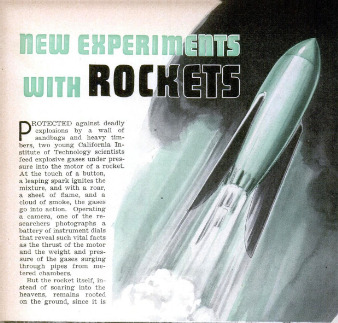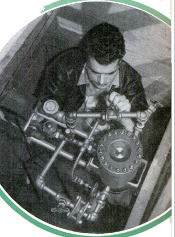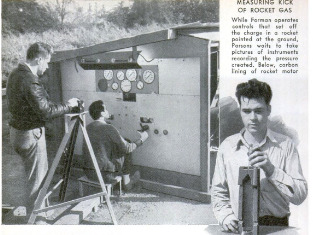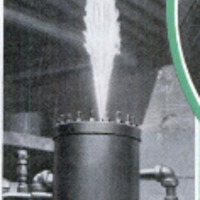-
Titolo
-
New experiments with rockets
-
Article Title and/or Image Caption
-
New experiments with rockets
-
extracted text
-
PROTECTED against deadly
explosions by a wall of
sandbags and heavy tim-
bers, two young California In-
stitute of Technology scientists
feed explosive gases under pres-
sure into the motor of a rocket.
~ At the touch of a button,
a leaping spark ignites the
mixture, and with a roar,
a sheet of flame, and a
cloud of smoke, the gases
go into action. Operating
a camera, one of the re-
searchers’ photographs a
battery of instrument dials
that reveal such vital facts
as the thrust of the motor
and the weight and pres-
sure of the gases surging
through pipes from me-
tered chambers,
But the rocket itself, in-
stead of soaring into the
heavens, remains rooted
on the ground, since it is
anchored in place and
pointed earthward. For
Edward S. Forman and
John W. Parsons, the
California rocket re-
searchers, are mainly
interested for the pres-
ent in studying the ac-
tion of various fuels for
stratosphere - stabbing
rocket ships, and the ef-
fect of their intense
heat on various types of
nozzles.
This question of rock-
et-motor nozzles is one
of the major problems
now facing rocket ex-
perimenters, who are
‘constantly devising new
improvements and new methods to
take the rocket out of the realm of
fantasy and into the field of practi-
cal use. Booster motors to assist
rocket take-off, gyroscopes to guide
flights along straight paths, water-
cooled nozzles, range finders to re-
cord altitudes and speeds, automatic
parachutes that return the rockets safely to |
earth—these are some of the devices that |
are now being tested and brought to per-
pala SoS nA wlll
dozen fronts.
North of Roswell, N. M, for instance,
rockets wobble skyward from a sixty-foot |
tower, and then straighten out into a true |
vertical path, soaring up two miles into the
air at a speed of more than 700 miles an
hour. At the top of their flight, they hang in |
air a split second, then tumble over and float |
gently down to earth as their parachutes
automatically belly out. The gyroscopic
mechanism that straightens out the initial |
take-off wabble is a development engineered
by Dr. Robert H. Goddard, rocket pioneer.
Stabilizing vanes attached to the rocket are |
automatically controlled by the gases of the
exhaust stream, moving the rocket back into
line when it wanders ten degrees away from
a vertical path.
But actually how close is rocket science to
practical exploration of the stratosphere at
an altitude of, say, fifty miles? Studies at
the California Institute of Technology lead
investigators to believe that with the ex-
haust velocity of 7,000 feet a second ob-
tained by Goddard's rockets, powder rockets
could now be built capable of rising 100,000
feet. In fact, under some conditions, they
believe a gas-propelled, eighty-five pound
rocket, exhausting its burned fuel through
a nozzle at the rate of 12,000 feet a second,
could rise under power to an altitude of fifty
‘miles, and then continue, “coasting,” straight
up for another 175 miles.
For more than three decades scientists
have sought ways to explore the atmosphere
at great heights. Today their thoughts are
turning to levels where rockets would fly
through a vacuum, and celestial observa-
tions might be made without interference
from city lights, haze, clouds, or air mole-
cules of lower altitudes. One well-known
astronomer even went 50 far as to suggest
the possibility of a complete astronomical
observatory, raised a thousand miles above
the earth by one set of rocket motors, and
maintained at that level by another.
Of more immediate practical application
is the proposal that rockets take over the
duties of heavy artillery in laying down a
concentrated bombardment of an intensity
not reached even with dive-bombing air-
planes and the latest type of field and rail-
way guns. Major James R. Randolph, of the
U.S. Army Ordnance Reserve, recently de-
clared that rockets could easily equal the
performances of long-range guns firing
shells as far as seventy miles.
‘These long-range cannon fire a projectile
eight inches in diameter. “Instead of firing
shots of moderate caliber at long intervals,”
said Major Randolph, “a rocket plant could
fire the equivalent of twenty-four-inch shells
as fast as desired.”
Projectiles envisaged by this officer would
weigh four tons. Thousands of them, set off
simultaneously or in volleys, might lay
down in a few minutes a withering barrage
that present artillery could equal only over
a long period of time.
Armor-piercing rockets, Randolph further
proposed, could be carried by submarines,
while on land, the rocket shells could be
transported in ordinary motor trucks bear-
ing no resemblance to artillery weapons now
easily identified by enemy planes.
-
Autore secondario
-
Robert E. Martin (article writer)
-
Lingua
-
eng
-
Data di rilascio
-
1940-09
-
pagine
-
108-110
-
Diritti
-
Public domain
-
Archived by
-
Sami Akbiyik
-
Marco Bortolami (editor)









